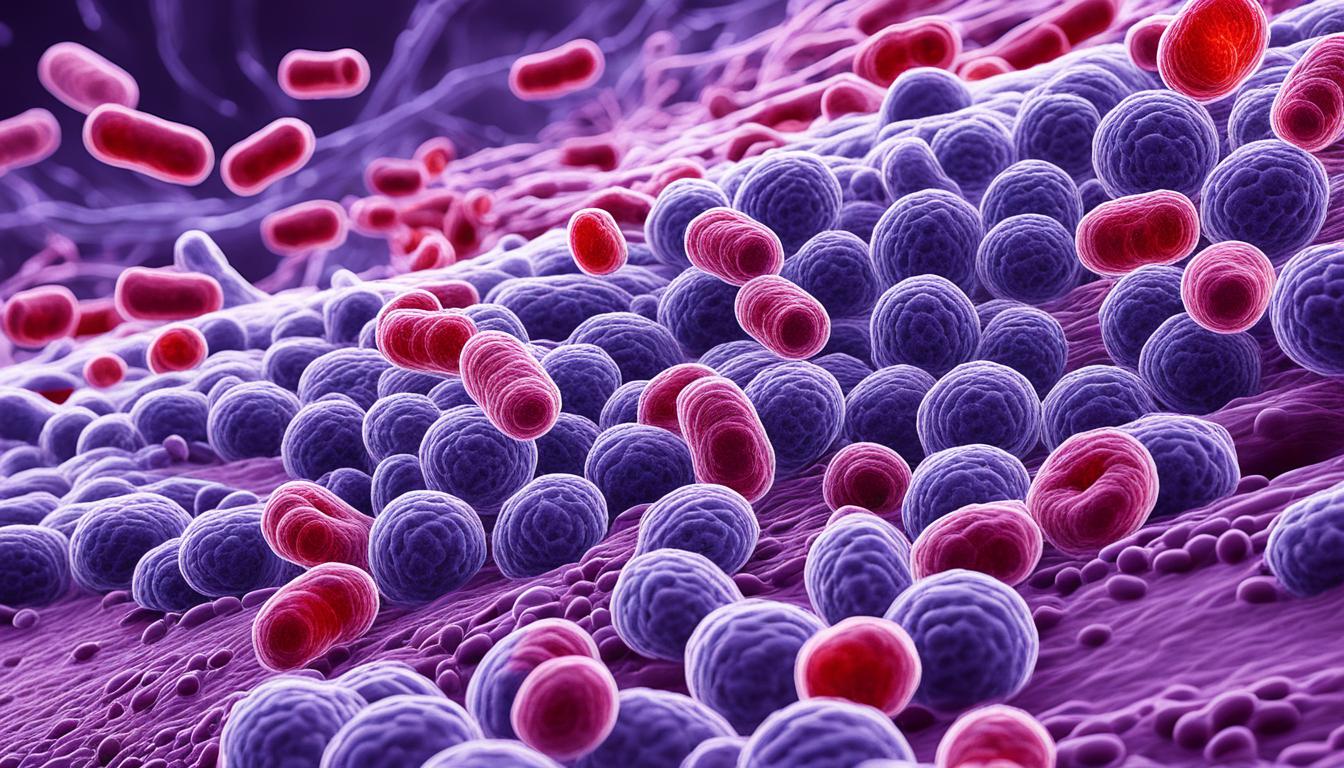C. difficile colitis, known as C. diff, happens most often in hospitals. It affects 15% to 25% of patients. People who have had a hematopoietic stem cell transplant (HSCT) are more likely to get it. This risk is higher if they had an allogeneic HSCT. These patients often take cytotoxic chemotherapy drugs that make them more prone to C. diff infections. Catching and treating it early in HSCT patients is really important to prevent severe illness and problems.
Stem cell therapy offers a new way to help those with C. difficile colitis. It aims to lower how often the disease comes back and to make treatment more successful.
Key Takeaways:
- C. difficile colitis is a type of nosocomial diarrhea, found frequently in HSCT patients.
- The use of certain chemotherapy drugs in HSCT patients makes them more vulnerable to C. diff.
- Acting quickly to diagnose and treat C. diff in these patients helps avoid serious issues.
- Stem cell therapy appears promising in lessening the disease’s return and improving treatment results.
Symptoms and Diagnosis of C. difficile colitis
C. difficile colitis, or Clostridioides difficile infection, has various symptoms. These can be from mild to severe. It’s important to know the symptoms and have a proper diagnosis swiftly for effective treatment and control of the infection.
Symptoms of C. difficile colitis
One of the main signs is watery diarrhea. This comes with many trips to the bathroom. It can cause dehydration and mess up your body’s salts and minerals. People might feel pain in their stomach, have a fever, and not want to eat. Sometimes, they might get a type of colitis that creates patches in their colon.
Diagnosis of C. difficile infection
Getting diagnosed right away is key for dealing with C. difficile. Doctors will test your stool to check for toxins. They use tests like enzyme immunoassay (EIA) and nucleic acid amplification. These tests show if the bacterium’s toxins are in your body.
There are times when a more in-depth look is needed. A doctor might do a colonoscopy or sigmoidoscopy. These let the doctor see if your colon has changed because of the infection.
In short, knowing the symptoms early and getting the right tests done is crucial. Quick action can stop more problems and make patients better.
Causes and Risk Factors of C. difficile colitis
The main cause of C. difficile colitis is swallowing C. difficile spores. These spores are in the air and on things like food, water, and surfaces. They are very tough and survive for a long time, making infection more likely.
Taking antibiotics recently is a big risk for C. difficile colitis. Antibiotics can kill the good bacteria in the gut. This lets C. difficile grow and cause a problem. Though not all antibiotic use causes this, it does raise the risk.
Older adults face a higher risk too. Their weaker immune systems and medical issues make them more vulnerable. Being in hospitals also adds to the risk. Hospitals can have the bacteria, and patients might touch things or meet staff who haven’t been careful about hygiene.
Having a weak immune system is a big risk factor for C. difficile. This can be from health issues or medicines that lower the immune system. A weak immune system lets the bacteria grow easily, leading to infection.
People getting a hematopoietic stem cell transplant (HSCT) are especially at risk. They stay in the hospital a lot and use many antibiotics. Their immune systems are very weak, increasing the chances of getting very sick from C. difficile.
To wrap up, C. difficile comes from its spores and a changed gut environment, often from antibiotics. Risk factors include older age, time in hospitals, weak immune systems, and HSCT. Knowing these causes and risks, doctors can better prevent and treat C. difficile.
Stem Cell Therapy for the Treatment of C. difficile colitis
Stem cell therapy is changing how we treat C. difficile colitis. It uses stem cells to fight the infection from its root. Mesenchymal stem cells are key, lowering how often it comes back and making patients better.
These special stem cells help the body fix the damage the infection caused. They balance the gut’s good and bad bacteria, stopping the infection from happening again. Many studies prove that this treatment is both effective and safe.
In Thailand, medical centers are leading in using stem cell therapy for this colitis. This new method gives hope to those who are tired of old treatments. It aims to provide long-term relief from the infection’s harsh effects.

